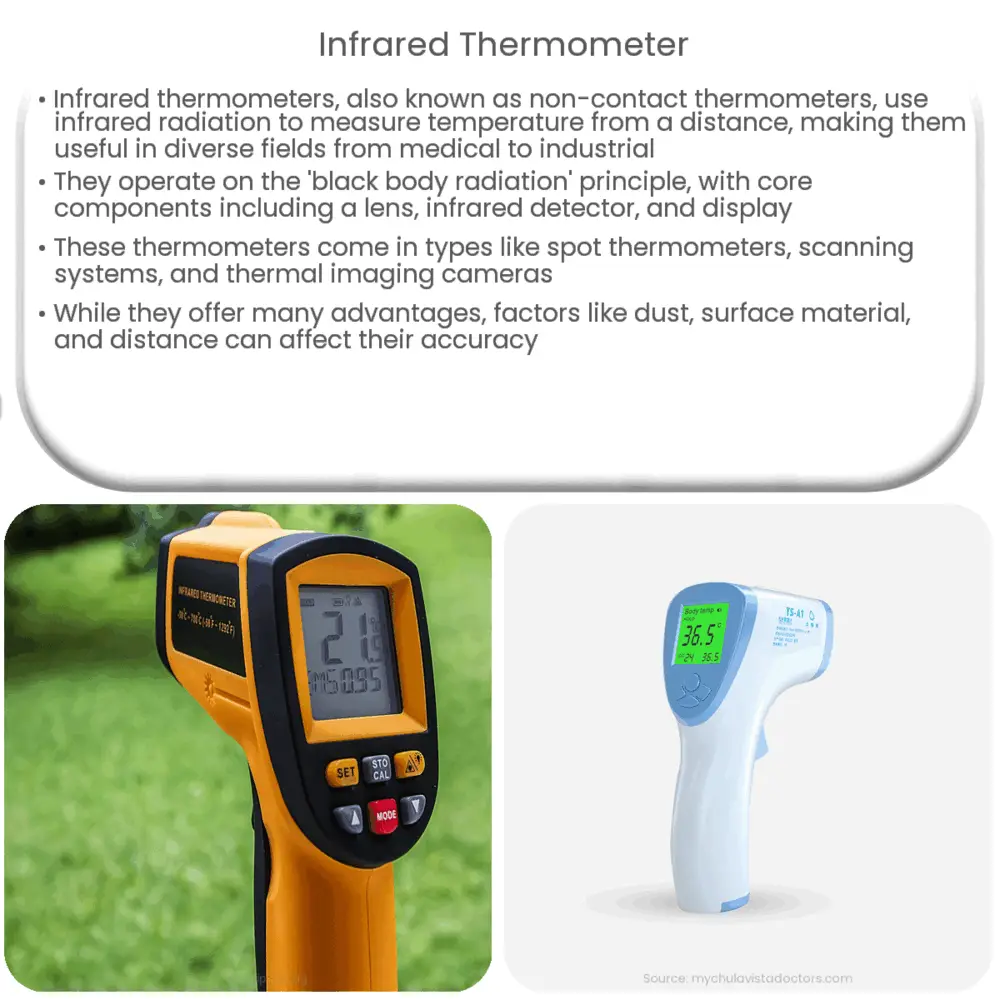Explore the working principle, types, benefits, and limitations of infrared thermometers in this comprehensive guide.

Infrared Thermometers: A Modern Temperature Measuring Tool
Infrared thermometers, also known as non-contact thermometers, have become a crucial tool in various fields, from medical to industrial sectors. They function on the principle of infrared radiation, which is a form of electromagnetic radiation invisible to the human eye but detectable in the form of heat.
Working Principle of Infrared Thermometers
Infrared thermometers work based on the concept of ‘black body radiation.’ This principle states that any object at a temperature above absolute zero emits infrared radiation. The amount of radiation emitted increases with the object’s temperature. The infrared thermometer can detect this radiation and convert it into a temperature reading.
Components of an Infrared Thermometer
- Lens: This component collects the infrared radiation from the object being measured. The lens is often made from materials like germanium, which are efficient at transmitting infrared radiation.
- Infrared Detector: This part transforms the collected infrared radiation into an electrical signal. This signal is then processed and displayed as a temperature reading.
- Display: This part of the thermometer shows the temperature reading. It often includes a backlight for easy reading in low-light conditions.
Benefits of Using Infrared Thermometers
One of the most significant advantages of infrared thermometers is their non-contact nature, allowing temperature measurement from a distance. This feature makes them particularly useful in situations where contact thermometers are impractical or unsafe, such as measuring the temperature of moving machinery, high voltage equipment, or a patient with a contagious disease.
Types of Infrared Thermometers
- Spot Infrared Thermometers: These devices measure the temperature at one spot on a surface. They are commonly used in industrial and laboratory settings.
- Infrared Scanning Systems: These systems scan larger areas and are often used in manufacturing processes to monitor the uniformity of heat distribution.
- Infrared Thermal Imaging Cameras: These devices provide a two-dimensional image of an area, with different colors representing different temperatures. They are often used in building inspections to detect heat leaks.
Limitations and Considerations
While infrared thermometers have many benefits, they also come with some limitations. The accuracy of an infrared thermometer can be affected by dust, smoke, or other particles in the air that can interfere with the path of the infrared beam. Additionally, the surface material of the object being measured can also influence the readings. Surfaces that are not good emitters of infrared radiation, such as shiny metal, can give misleading results.
Infrared thermometers must also be used at a specific distance from the object, known as the ‘spot size.’ The further the thermometer is from the object, the larger the spot size becomes, and the less accurate the measurement will be. This ratio of distance to spot size is often represented as D:S (distance-to-spot ratio). A higher D:S ratio is generally better for measuring smaller objects from a distance.
Conclusion
In conclusion, infrared thermometers are a vital tool in many industries and settings due to their ability to measure temperature from a distance and their speed of measurement. They operate based on the principle of infrared radiation and are made up of components such as a lens, an infrared detector, and a display.
These devices come in various types, such as spot infrared thermometers, infrared scanning systems, and infrared thermal imaging cameras, each serving a unique purpose. While they have limitations, understanding these can help optimize their use. As technology continues to advance, we can expect even more improvements and applications for these versatile instruments.

